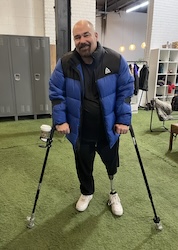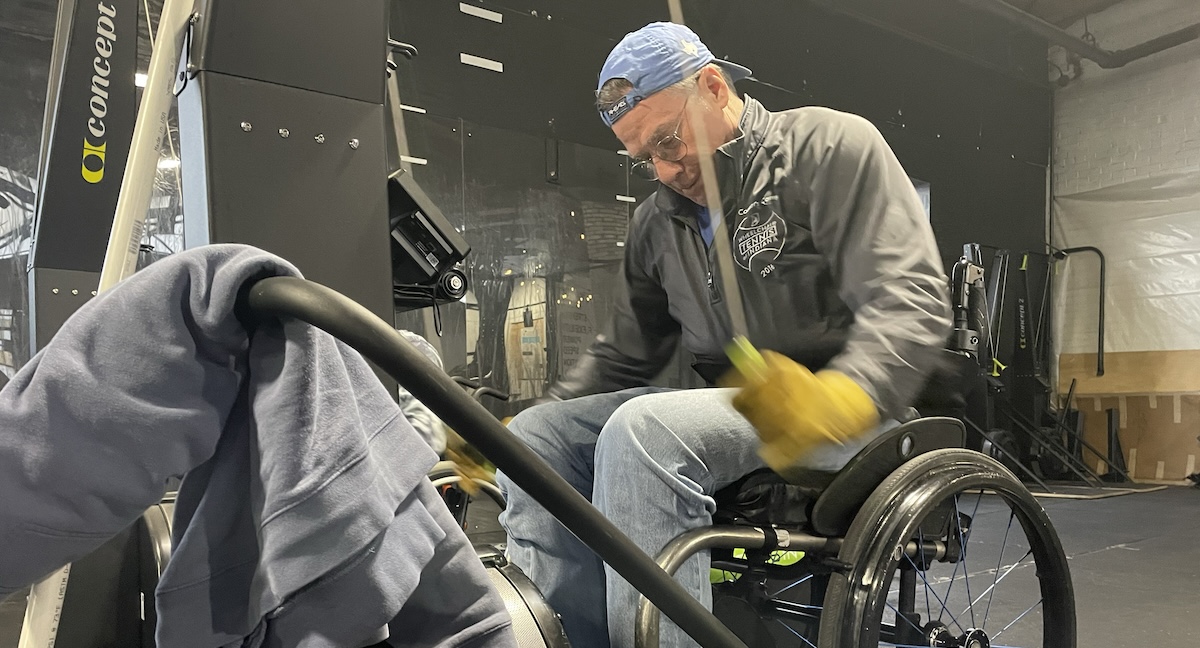LAWRENCE — Brian McMillan, 65, attends fitness classes four times a week through the Adaptive Athletes in Motion program, which is designed for people with mobility challenges.
“You need strength to get through life,” he said.
McMillan and the other “adaptive athletes” who take part in the classes, aged between 14 and 73, have physical conditions that limit their ability to move, from ataxia to multiple sclerosis to spinal cord injuries.
Known as high-intensity functional training (HIFT), this community-based program is similar to CrossFit and is the focus of ongoing research by University of Kansas researcher Lindsay Kuhn, associate director of the Center for Independent Living Research and Training at the University of Kansas Lifespan Institute.
McMillan took a break from using the ski ergometer machine at Brave Enough CrossFit in North Kansas City, Missouri, explaining that she relies on arm and torso movements to get her heart rate up and keep her body moving without using her legs.
“When you sit in a chair for 21 years, your abdominal muscles weaken,” he says, “so if you’re not burning off those extra calories, you’re just eating them.”
 Daniel Bufford, 53, of Merriam, lost a leg in a motorcycle accident and gained 50 pounds. He joined Adaptive Athletes in Motion to get healthy and found a new sense of purpose. “This experience has truly transformed me,” Bufford said.
Daniel Bufford, 53, of Merriam, lost a leg in a motorcycle accident and gained 50 pounds. He joined Adaptive Athletes in Motion to get healthy and found a new sense of purpose. “This experience has truly transformed me,” Bufford said.
People with mobility impairments are 66% more likely to be overweight or obese than people without disabilities, and are at higher risk of cardiovascular disease, depression and anxiety. Despite evidence that exercise improves health and well-being, less than half of adults with mobility impairments are physically active.
Kuhn said community-based exercise programs as a health intervention have been understudied and overlooked by doctors, many of whom recommend surgery or medication over exercise for people with disabilities.
“While there is little empirical evidence about the effectiveness of this type of movement (HIFT) on people with disabilities, people with disabilities are actively engaged in HIFT in communities across the country and around the world,” Kuhn said.
Kuhn is leading three pilot projects to evaluate the effectiveness of HIFT in improving a range of health outcomes, including fall risk, metabolic health, strength, flexibility, quality of life and mental health. His research is supported internally through a KU Research GO award that ends in April, and also by the Kansas Metabolic and Obesity Research Center, which is funded by the National Institutes of Health’s Center for Biomedical Research Excellence, and the Landon Center on Aging at KU Medical Center.
“It’s very important to me and a goal of my work that people with mobility issues, especially those who age with long-term disabilities, can live functionally independent lives,” she said. “My hope is that people can get up off the ground if they fall, get down on the ground to play with their kids or grandkids, carry groceries into their home on their own, and have the support of others in the community to stay healthy.”
Despite the many benefits of exercise, including improved brain health, weight management, reduced risk of disease, stronger bones and muscles and improved ability to perform daily activities, most community facilities are not accessible or even welcoming to people with physical disabilities, Kuhn said.
Furthermore, although outpatient physical and occupational therapy can provide temporary benefits to individuals with disabilities, these services are typically prescribed post-injury and are often short-term with limited total visits; they are not a long-term strategy for activity participation.
Kansas City’s HIFT program, developed by Josh Snyder, is known as Adaptive Athletes in Motion (AAIM) and offers opportunities for individuals at several locations in the area, including Mission Barbell Club in Mission, Kansas Athletic Club in Overland Park, FITNKC in Kansas City, Missouri, and Kaw Valley CrossFit in Lawrence.
“Josh has a knack for this,” Kuhn said. “No matter what type of disability someone has, he can create a program based on their abilities and their personal goals.”
Kuhn said trainers work one-on-one with new athletes in onboarding sessions after reviewing any health concerns, exercise limitations and health goals.
After losing movement in her legs in a motorcycle accident, McMillan learned how to dress, move around and take care of herself with the help of therapists.
“But that doesn’t last long, and then you’re on your own to fend for yourself,” McMillan said.
In the AAIM program, you do something different every day to keep your muscles and mind active.
Daniel Bufford, 53, of Merriam, said he lost a leg in 2022 and gained about 50 pounds. Originally from the Dallas area, he moved to Kansas City for a fresh start after Steps of Faith, a nonprofit in the area, offered to pay for a prosthetic limb.
He joined AAIM last spring and now attends classes several times a week and occasionally works as a volunteer coach. He said he gets depressed when he doesn’t exercise.
“It’s really changed me,” Bufford said. “I’m so competitive now. I’ve competed in CrossFit competitions. I’ve only competed in one before, but now I’m planning on competing in a lot of competitions.”
Another benefit of fitness classes is the support and connection of a community, which for Bufford helps give her a sense of purpose.
“One of my friends that I train with is a double amputee,” Bufford said, “and he only has one arm, and we joke around a lot, and you can tell a lot of us are like that, because if you can’t laugh at yourself, you’re not going to be able to relate to other people.”
Kuhn said HIFT incorporates functional movements to assist with everyday activities such as picking up objects from a seated position, transferring, reaching overhead, getting up from the floor and walking without support. But another benefit of HIFT classes for people with disabilities is that such programs have become popular nationwide and internationally, making them accessible to many people with disabilities.
“The best thing about our study is that participants had the option to stay in the program after the intervention ended,” she said.
So far, approximately 60%-70% of participants have chosen to continue their participation in AAIM programs.
Kuhn said the research is still in its early stages, but her work is helping gather empirical evidence about the program’s effectiveness, expanding the program around Kansas City and Lawrence, increasing reach to new people in the community and increasing exposure to other HIFT programs who may be interested in starting their own adaptation classes.
“That was very rewarding to see,” she said.

